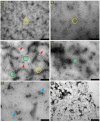Functional Amyloid Protection in the Eye Lens: Retention of α-Crystallin Molecular Chaperone Activity after Modification into Amyloid Fibrils
- PMID: 28895938
- PMCID: PMC5618248
- DOI: 10.3390/biom7030067
Functional Amyloid Protection in the Eye Lens: Retention of α-Crystallin Molecular Chaperone Activity after Modification into Amyloid Fibrils
Abstract
Amyloid fibril formation occurs from a wide range of peptides and proteins and is typically associated with a loss of protein function and/or a gain of toxic function, as the native structure of the protein undergoes major alteration to form a cross β-sheet array. It is now well recognised that some amyloid fibrils have a biological function, which has led to increased interest in the potential that these so-called functional amyloids may either retain the function of the native protein, or gain function upon adopting a fibrillar structure. Herein, we investigate the molecular chaperone ability of α-crystallin, the predominant eye lens protein which is composed of two related subunits αA- and αB-crystallin, and its capacity to retain and even enhance its chaperone activity after forming aggregate structures under conditions of thermal and chemical stress. We demonstrate that both eye lens α-crystallin and αB-crystallin (which is also found extensively outside the lens) retain, to a significant degree, their molecular chaperone activity under conditions of structural change, including after formation into amyloid fibrils and amorphous aggregates. The results can be related directly to the effects of aging on the structure and chaperone function of α-crystallin in the eye lens, particularly its ability to prevent crystallin protein aggregation and hence lens opacification associated with cataract formation.
Keywords: amyloid fibril; molecular chaperone; protein aggregation; protein unfolding; small heat-shock protein.
Conflict of interest statement
The authors declare no conflict of interest. The funding sponsors had no role in the design of the study; in the collection, analyses, or interpretation of data; in the writing of the manuscript, and in the decision to publish the results.
Figures





Similar articles
-
The Aggregation of αB-Crystallin under Crowding Conditions Is Prevented by αA-Crystallin: Implications for α-Crystallin Stability and Lens Transparency.J Mol Biol. 2020 Sep 18;432(20):5593-5613. doi: 10.1016/j.jmb.2020.08.011. Epub 2020 Aug 19. J Mol Biol. 2020. PMID: 32827531
-
AlphaB-crystallin, a small heat-shock protein, prevents the amyloid fibril growth of an amyloid beta-peptide and beta2-microglobulin.Biochem J. 2005 Dec 15;392(Pt 3):573-81. doi: 10.1042/BJ20050339. Biochem J. 2005. PMID: 16053447 Free PMC article.
-
Proteostasis and the Regulation of Intra- and Extracellular Protein Aggregation by ATP-Independent Molecular Chaperones: Lens α-Crystallins and Milk Caseins.Acc Chem Res. 2018 Mar 20;51(3):745-752. doi: 10.1021/acs.accounts.7b00250. Epub 2018 Feb 14. Acc Chem Res. 2018. PMID: 29442498 Review.
-
Characterisation of amyloid fibril formation by small heat-shock chaperone proteins human alphaA-, alphaB- and R120G alphaB-crystallins.J Mol Biol. 2007 Sep 14;372(2):470-84. doi: 10.1016/j.jmb.2007.06.060. Epub 2007 Jun 29. J Mol Biol. 2007. PMID: 17662998
-
Crystallin proteins and amyloid fibrils.Cell Mol Life Sci. 2009 Jan;66(1):62-81. doi: 10.1007/s00018-008-8327-4. Cell Mol Life Sci. 2009. PMID: 18810322 Free PMC article. Review.
Cited by
-
The major inducible small heat shock protein HSP20-3 in the tardigrade Ramazzottius varieornatus forms filament-like structures and is an active chaperone.Cell Stress Chaperones. 2024 Feb;29(1):51-65. doi: 10.1016/j.cstres.2023.12.001. Epub 2023 Dec 5. Cell Stress Chaperones. 2024. PMID: 38330543 Free PMC article.
-
The Effect of Oxidized Dopamine on the Structure and Molecular Chaperone Function of the Small Heat-Shock Proteins, αB-Crystallin and Hsp27.Int J Mol Sci. 2021 Apr 2;22(7):3700. doi: 10.3390/ijms22073700. Int J Mol Sci. 2021. PMID: 33918165 Free PMC article.
-
Trehalose Inhibits the Heat-Induced Formation of the Amyloid-Like Structure of Soluble Proteins Isolated from Human Cataract Lens.Protein J. 2020 Oct;39(5):509-518. doi: 10.1007/s10930-020-09919-8. Epub 2020 Oct 10. Protein J. 2020. PMID: 33037983
-
p53 amyloid aggregation in cancer: function, mechanism, and therapy.Exp Hematol Oncol. 2022 Sep 28;11(1):66. doi: 10.1186/s40164-022-00317-7. Exp Hematol Oncol. 2022. PMID: 36171607 Free PMC article. Review.
-
Structural and Functional Peculiarities of α-Crystallin.Biology (Basel). 2020 Apr 23;9(4):85. doi: 10.3390/biology9040085. Biology (Basel). 2020. PMID: 32340218 Free PMC article.
References
Publication types
MeSH terms
Substances
LinkOut - more resources
Full Text Sources
Other Literature Sources

